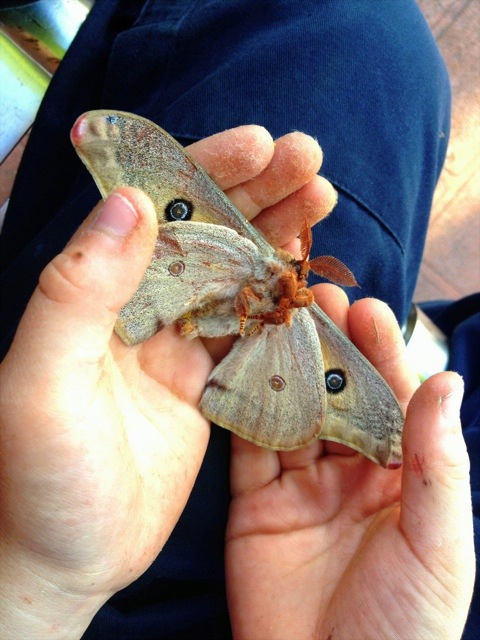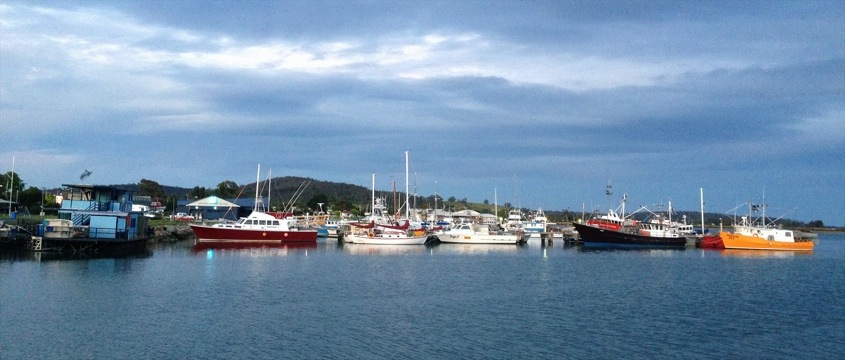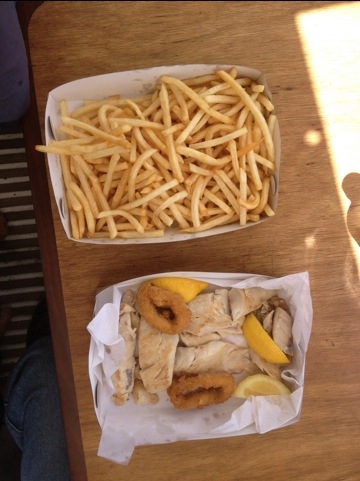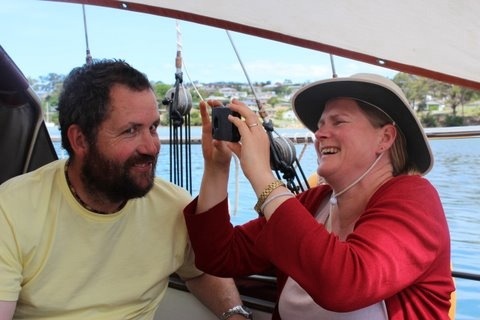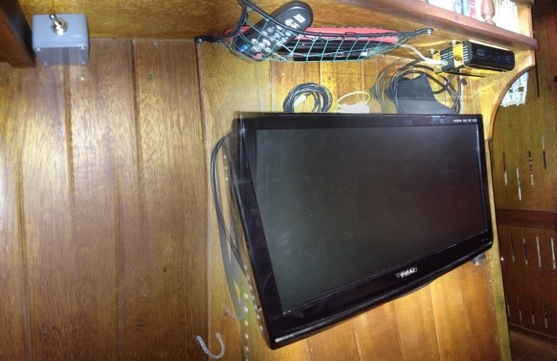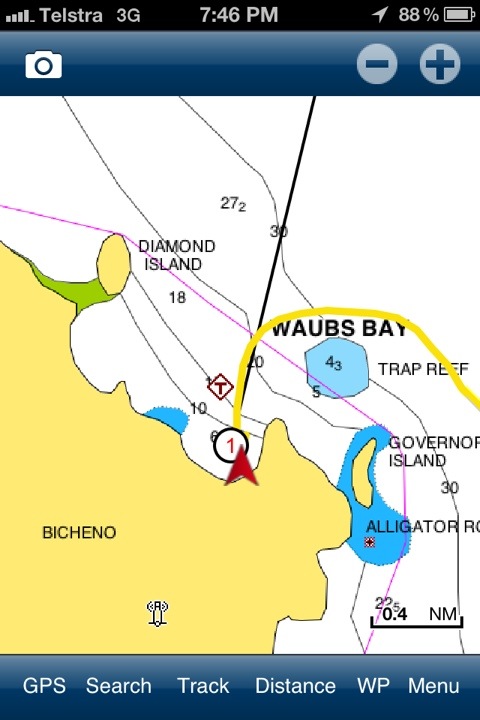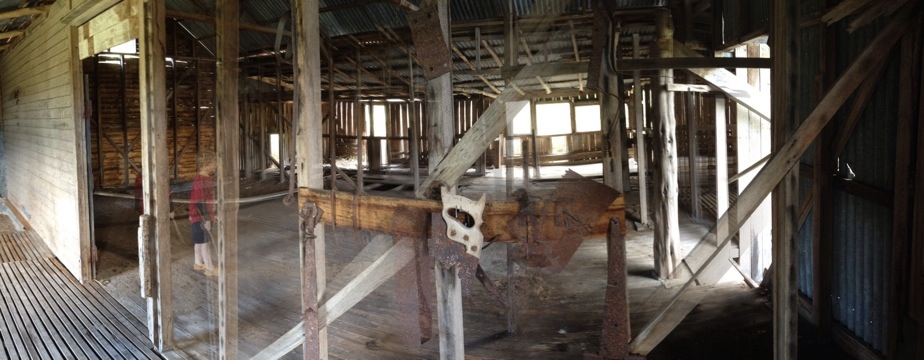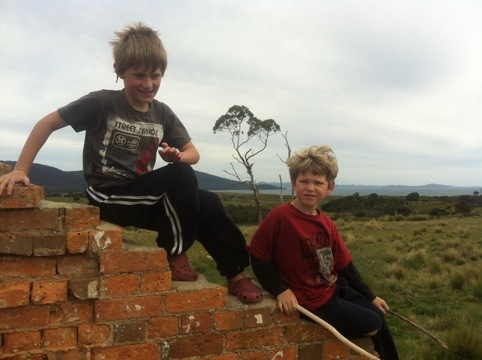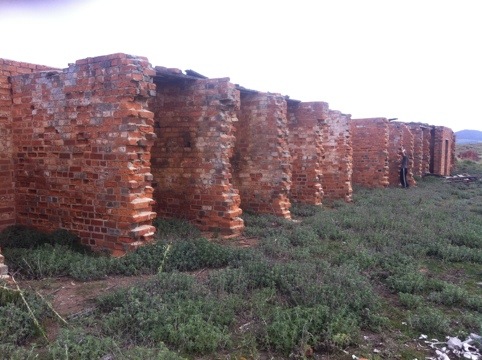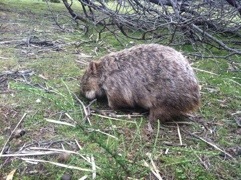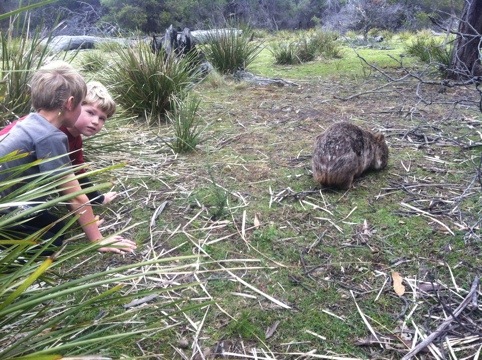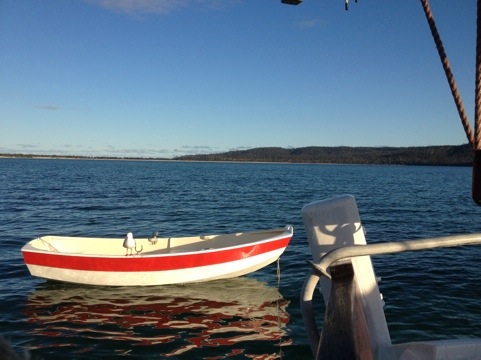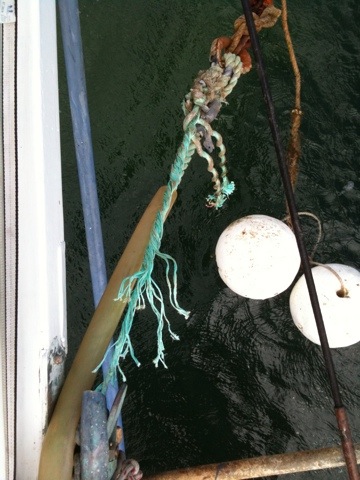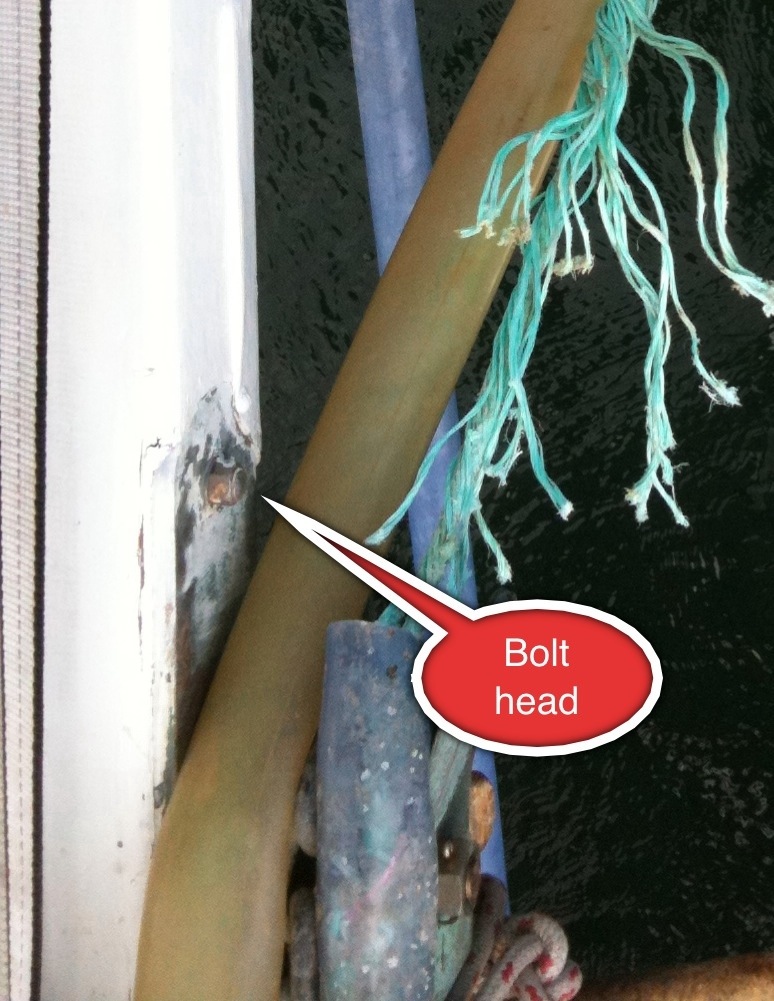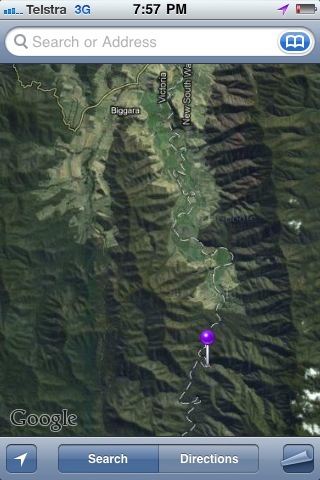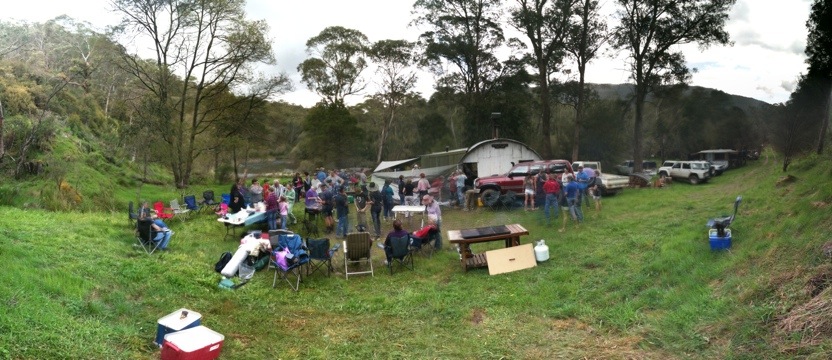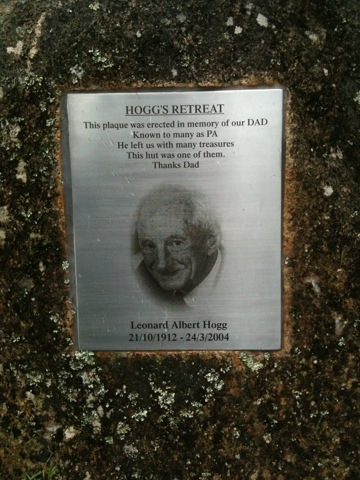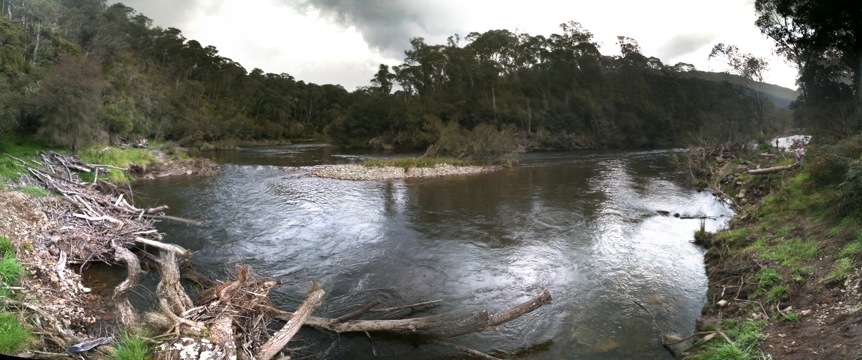We set off from Chinaman’s at 0500 with mizzen and staysail and beat our way south in a heavy rain squall against a 20kt sou’westerly. It was cold, dark and miserable.
We made our way southwest to clear the off lying hazard south of Long Point and got ourselves into Mercury Passage before turning west then north on a course that would take us up the inside of Maria Island, to the west of Ile des Phoques and up around the marker for Black Reef, to the west of Shouten Island. The idea was to scope the area out as a possible anchorage, but ideally, we wanted to just pass through and admire the coastline of the Peninsula. Our aim was to make Wineglass Bay.
As we cleared Maria, the primary southerly swell and the secondary north easterly swell made themselves known, and we had a rolling, surging and uncomfortable ride in the 2 or 3 meter conditions north. Both boys got seasick. With the rain squalls and the constant attention required at the helm, it wasn’t that much fun riding the 20 to 25kt southwesterly up the coast. Five hours later, we got into the lee of Shouten Island to find a couple of tourist boats taking shelter too.
We debated whether to stop there for the day or keep going another two hours to Wineglass. The kids had perked up, now we were out of the weather, and with more westerly weather due to come in, I wasn’t keen to stay in the passage; the was a strong westerly in the forecast. The north easterly swell was rolling in too. We decided to put out to sea again and make for Wineglass, as the conditions couldn’t have been worse than what we’d just seen…. Could they?
How wrong we were.
There must have been some tide through the passage because the waves were standing up to 4 or 5 meters without a lot of back to them and about two boat lengths apart. With the swell curling around Shouten Island,we had to bash against it for two nautical miles offshore before we could get a decent angle on them to clear the headlands of the Freycinet Peninsula and make for Wineglass Bay.
Once we were running with the conditions, it was sort of okay, becoming worse when the wind would die below 15 knots and cease to hold the boat stable. The crew quickly succumbed to seasickness again, and there was much vomiting witnessed by the skipper. Poor Alex was crying because his arm hurt from holding on so hard, but he refused to go below. My dear wife was out to it, and after hearing a bang from something falling down below, I saw Lachie lying on the cabin sole, dry reaching into a towel.
It took two and half hours to get into the shelter of the bay, and after we dropped anchor in the southern corner, I went below to survey the damage from the passage of eight and a half hours.
The oil latern had come loose from it’s restraint, and had taken to wearing a hole in the bulkhead partition forward of the galley. The tool draw had sprung it’s latch and slid out, blown it’s stops and come to rest on the floor, the runners bent. Charts had fallen off the chart table, books had leapt from the book cases. The kettle had jammed itself down behind the stove. Lachie reported a number of things falling on him personally.
Despite all that, it only took Lis ten minutes to clean up and get everything sorted out. With the kettle boiled she made us all a hot cup of tea and got some food heated up. Cold and feeling a bit sorry for ourselves, we got into dry clothes and treated ourselves to an early night watching “Return of the King” and a making-of disc, about 6 hours of entertainment that certainly put a dent in the battery capacity.
That night was spent rolling as the boat weather cocked to the sou’westerly, going beam on to the incoming swell. The next day we got up late and rowed out the second anchor and set it from the stern to hold us inline with the swell. A big improvement.
After the now customary arguments against doing any schoolwork, we managed to get the boys into their studies a little. Kim and Kerry, the crew of Yarraki and friends of our from Kings Pier Marina, were walking back from Mt. Graham that day. They gave us a ring and we set off at lunchtime to meet them at the north end of the beach.

It was great to catch up with them. We shared leftover whiskey and chocolate, and had quite the enjoyable lunch. The local wildlife also kept the boys entertained, coming close enough for them to pat. Methinks the tourists feed them.
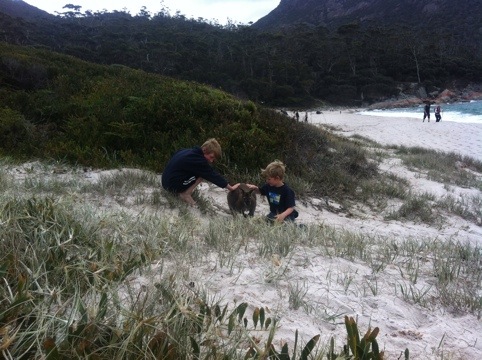
We were sorry they had to go, and I seriously considered following them after they talked up the joys of the spa at the place they were staying (Nick, of Acteon also in the Kings Pier Marina, owns the house at Coles Bay).
The following day I fixed the drawer and had another discussion with the boys about the requirement for home schooling. The boys and I went ashore to give Lis some time to write, and we spent the day exploring the south end of the beach.

The boys found some Southern Right whale rib bones, leftover from the days when there was a whaling station in the southern end of Wineglass (where the southern beach campsite is now).
I later learned that George Meredith, one of the first settlers at Swansea, had established a whale ‘fishery’ at Parsons Cove in 1824. It became known as ‘The Fisheries’. The sparkling waters and white sands of Wineglass Bay and Schouten Island soon became polluted with blood and putrid whale blubber as stations were established in those localities. Wineglass Bay didn’t get it’s name from the shape of the bay; it was from the colour of the water… Blood red.
I know life was hard, the blokes were a pretty rugged bunch, and the hunting of whales is a terrible thing, but you have got to give some credit to the tough and seaworthy men that undertook it. After a long and often dangerous chase in small whale-boats, the whales, displacing many times what the boat would weigh, would be ‘struck’ with a hand-thrown harpoon. This attached a line to the whale which, when weary from the struggle, was killed with an instrument called a lance. The carcass was then laboriously towed by the towers back to the shore for processing. Oil was extracted by boiling down the blubber in large iron trypots. It was then cooled and barrelled ready for shipping.
The whale oil was principally exported to Britain where it was used for lighting and as an industrial lubricant. The whale-bone or ‘baleen’ became the mainstay of the fashion industry, being used to make skirt hoops and corsets. The proceeds from a single whale were enough to keep a boat crew and their families well fed for a good while. In today’s money, a barrel of whale oil was worth $520.00, and there was about 30 barrels from a single Southern Right whale.
With that much money to be had, unsurprisingly, by the 1840s shore-based whaling was in decline. Whale stocks had been severely reduced due to years of ruthless exploitation. Pelagic (deep-sea) whaling, with the sperm whale as the main quarry, then dominated the industry until the 1880s.
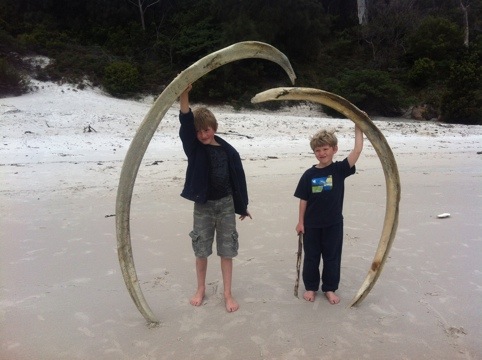
When we got back, Lis wasn’t a happy camper. She had found it difficult to get into writing, as she was worried about the difficulties we were having getting the boys into schoolwork. We had a long talk, where we explored those concerns, and mine regarding our finances and the challenges of our passages thus far. I was concerned that if anything should happen to the crew while undertaking those difficult passages, I wouldn’t be able to attend to them and the boat at the same time.
In short, this cruising lark hasn’t been all fun… Or even half fun… More like 40% fun, 60% hard work. We agreed to give it till Christmas to improve and continue, or fail to and not.
With the strong southerly conditions continuing to hold us here till the end of the week before we make a 12 hour run to St. Helens, I decided the following day to walk into the Coles Bay township for some green veggies.
We set off as a family at about 0930 and made the lookout at the saddle in the Hazards by about midday. Lachie and I then pushed on while Lis and Alex turned back.
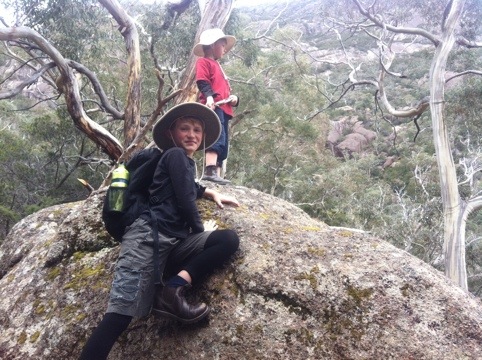
It was a fair old walk, taking about eight or nine hours to return to the boat. Lachie was great on the long walk, a real trooper.
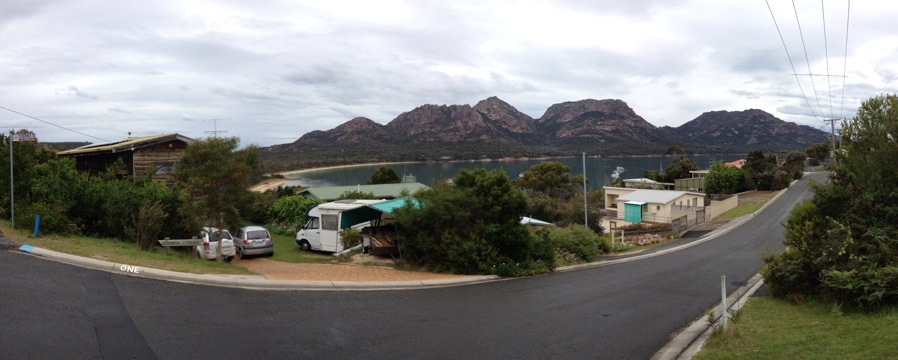
The following day (Wednesday), the weather picked up again, swinging southwesterly with another cold front coming through. Inspired by our trip the day before, Lis embarked on a trip up the beach. She then crossed over to Hazards Beach then around to the car park before climbing the saddle to the lookout and back along the beach to the anchorage again. It’s about five hours.
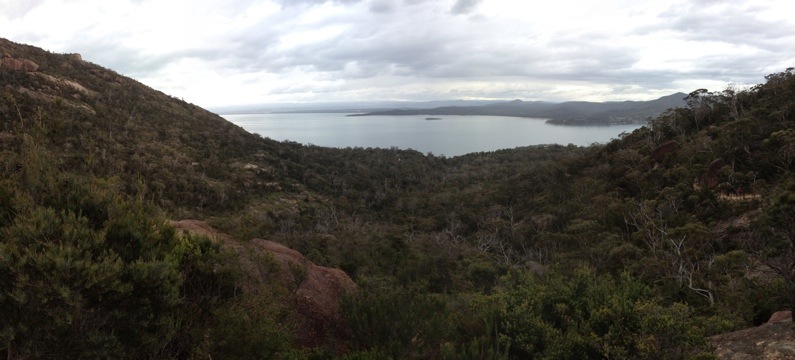
It was time to say goodbye to Wineglass Bay. I had a chat with a local tour boat operator to get an idea of the conditions outside, and talked to the St. Helens coastal rescue people about the conditions and plan for crossing the bar. Now it all it was going to take was a weather window.
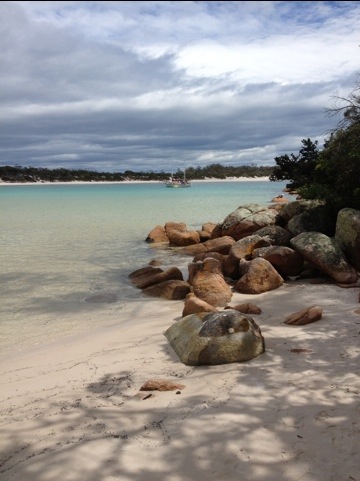
With the weather swinging to the west with the approach of of a slow moving high pressure system, we figured Friday would be our day….
It was not to be.



